COMMENT OF THE DAY: WHAT WE MEAN NOW WHEN WE TALK ABOUT ‘TRADITIONAL’ BUILDING  “. . . A ‘real’ dome would be constructed of stacked bricks that rest on each other and use physics to stay in place, like they did in the ancient times that you seem to be so fond of. This is a faux dome made of steel meant to replicate a classical look. Just because something mimics an older style, does not mean that it’s any more ‘real’ than the new stuff.” [Superdave, commenting on New Dome Rises from the Streets of Montrose to Top Church Position] Illustration: Lulu
“. . . A ‘real’ dome would be constructed of stacked bricks that rest on each other and use physics to stay in place, like they did in the ancient times that you seem to be so fond of. This is a faux dome made of steel meant to replicate a classical look. Just because something mimics an older style, does not mean that it’s any more ‘real’ than the new stuff.” [Superdave, commenting on New Dome Rises from the Streets of Montrose to Top Church Position] Illustration: Lulu
Construction Materials

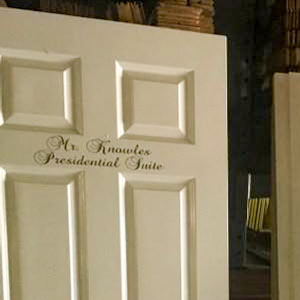 Interested in a bit of booty plundered from the the birthplace of Bootylicious? The former Rice Mansion at 1505 Hadley St. in Midtown most recently served as the headquarters of Mathew Knowles’ Music World Entertainment and moonlighted as a wedding and event venue. According to Architectural Digest, Destiny’s Child recorded Bootylicious, as well as several other of its hit songs, inside this building. But Knowles sold the entire block bounded by Hadley, Crawford, Webster, and LaBranch streets late last year, and its new owner — Group 1 Automotive, the parent company of the neighboring Midtown Advantage BMW car dealership — has begun demolishing the structures sitting on it one by one.
Interested in a bit of booty plundered from the the birthplace of Bootylicious? The former Rice Mansion at 1505 Hadley St. in Midtown most recently served as the headquarters of Mathew Knowles’ Music World Entertainment and moonlighted as a wedding and event venue. According to Architectural Digest, Destiny’s Child recorded Bootylicious, as well as several other of its hit songs, inside this building. But Knowles sold the entire block bounded by Hadley, Crawford, Webster, and LaBranch streets late last year, and its new owner — Group 1 Automotive, the parent company of the neighboring Midtown Advantage BMW car dealership — has begun demolishing the structures sitting on it one by one.
For now, the Rice Mansion — minus a bunch of salvaged parts and furnishings, which were yanked out recently — is still standing. But some of its parts have already been spotted by a Swamplot reader on an internet auction site. Though the building is more than a century old, the offered materials are clearly of far more recent vintage. Behold:
COMMENT OF THE DAY RUNNER-UP: IT’S NOT WHAT YOU HAVE, IT’S HOW IT’S ATTACHED  “As an engineer who regularly performs inspections of homes/businesses, I don’t think there’s an issue with stucco itself. If properly installed and maintained, it works fine. Maintenance is just as important as installation, however most home owners do a poor job of regular maintenance on their house and just blame the builder for any issues that appear 5 years down the road. A good practice is to inspect and re-caulk any seals on the exterior of your house every year, preferably before the spring rainy season.
However, I wouldn’t go with the impermeable barrier system in Houston, which assumes that no moisture will get behind the wall (so there are no weep holes at the bottom). I’d rather have a ‘breathable’ building envelope, because keeping moisture out is very difficult with the soil conditions and climate we have in the area.” [Chase, commenting on Comment of the Day: Why Is Houston Still Stuck on Stucco?] Illustration: Lulu
“As an engineer who regularly performs inspections of homes/businesses, I don’t think there’s an issue with stucco itself. If properly installed and maintained, it works fine. Maintenance is just as important as installation, however most home owners do a poor job of regular maintenance on their house and just blame the builder for any issues that appear 5 years down the road. A good practice is to inspect and re-caulk any seals on the exterior of your house every year, preferably before the spring rainy season.
However, I wouldn’t go with the impermeable barrier system in Houston, which assumes that no moisture will get behind the wall (so there are no weep holes at the bottom). I’d rather have a ‘breathable’ building envelope, because keeping moisture out is very difficult with the soil conditions and climate we have in the area.” [Chase, commenting on Comment of the Day: Why Is Houston Still Stuck on Stucco?] Illustration: Lulu
COMMENT OF THE DAY: WHY IS HOUSTON STILL STUCK ON STUCCO? 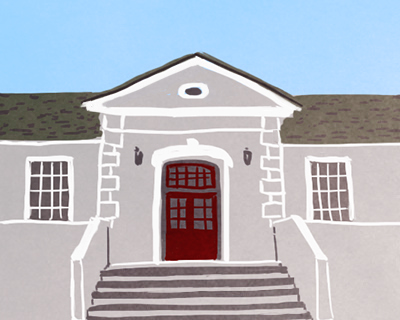 “Stucco seems to have more long term durability and maintenance problems than just about anything else, yet it seems to be the exterior of choice in nearly all high-end construction. Why?” [Skeptic, commenting on If You Like the Idea of Living Upstairs from Kay’s Lounge, Here’s the Next Best Thing] Illustration: Lulu
“Stucco seems to have more long term durability and maintenance problems than just about anything else, yet it seems to be the exterior of choice in nearly all high-end construction. Why?” [Skeptic, commenting on If You Like the Idea of Living Upstairs from Kay’s Lounge, Here’s the Next Best Thing] Illustration: Lulu
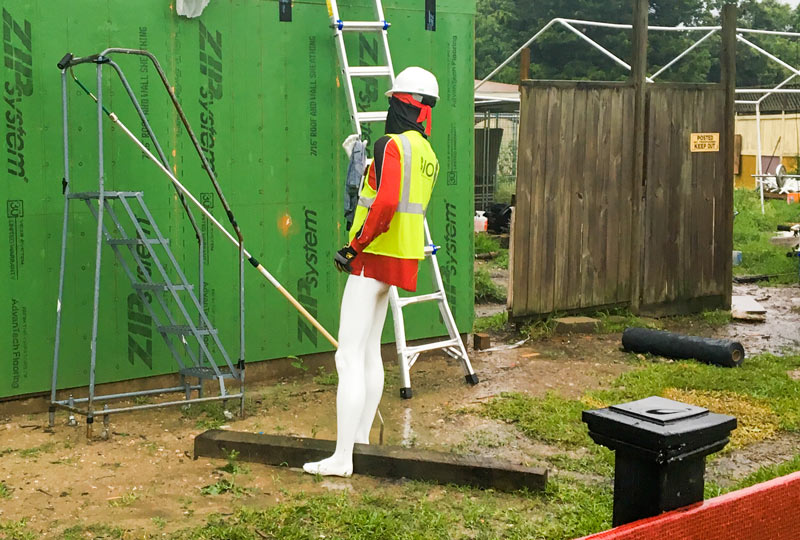
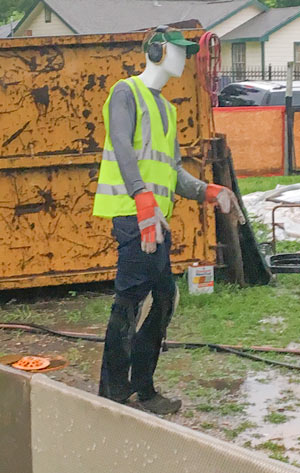 Something caught the eye of occasional construction scrutinizer Tuco Ramirez yesterday at the corner of McHenry and Carothers streets (and not just the site’s elaborate and colorful vinyl construction fencing): what appeared to be 2 workers on the job in the middle of the downpour and accompanying lightning. Upon slowing down to take a closer look, Ramirez realized the figures “were standing still — turns out they weren’t working at all.”Â
Something caught the eye of occasional construction scrutinizer Tuco Ramirez yesterday at the corner of McHenry and Carothers streets (and not just the site’s elaborate and colorful vinyl construction fencing): what appeared to be 2 workers on the job in the middle of the downpour and accompanying lightning. Upon slowing down to take a closer look, Ramirez realized the figures “were standing still — turns out they weren’t working at all.”Â
Above are some close-ups of the mannequins snapped after the rain slowed down; while both do appear to be making an effort to model some level of appropriate protective gear, each still lacks a few of the basics, from safety goggles to pants. “Have to admit, if it wasn’t pouring cats and dogs at the time, I would never have noticed they were fake,” continues Ramirez. “I got out of my truck to snap these shots from a good perspective, but I assure you they look very convincing from the street view.”
Here’s the rest of the scene:
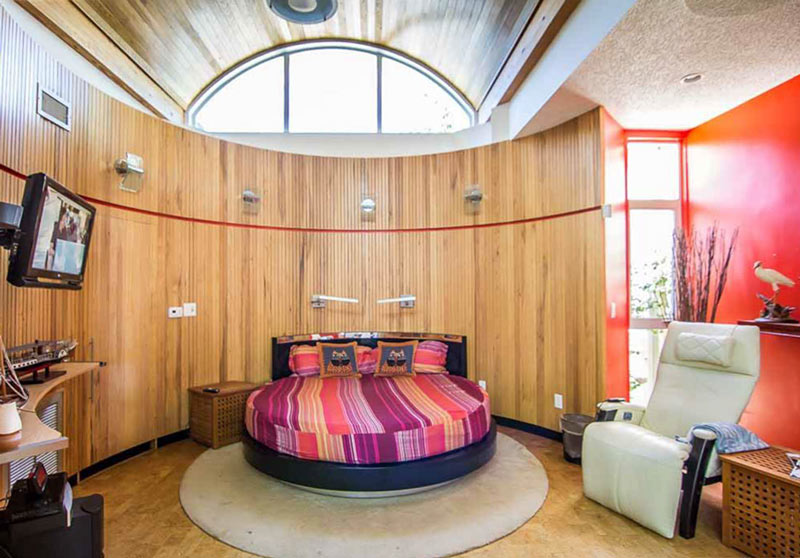
Positioned above a fork in Spring Branch Creek just north of I-10, this 1971 mod was designed by former occupant Roland Beach, who passed away last April after living in the home for more than 40 years with his family. Beach, an exporter of construction materials to Barbados, produced much of the 2,630-sq.-ft. home’s extensive wood paneling and detailing in his own shop in the property’s detached 2-car garage.
His 3-bedroom, 3-bath dreamhouse was remodeled in 2008, when Beach added a master suite containing a round sleeping area, a sauna, and a kitchenette with dining space — allowing occupants to get away from it all without actually leaving the home. The house was named one of Houston Mod’s “Mods of the Month” for November; the asking price dropped to $825k from just under $840k at the end of October, after a few weeks on the market.
COMMENT OF THE DAY: FLOATING THE STUCK-ON STONE BELOW THE STUCCO 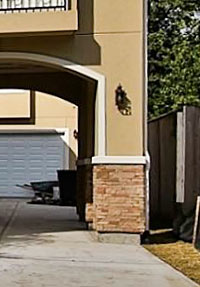 “Can just one builder find a way to transition a column [see photo detail at right] to the ground instead of the ridiculous ‘high-water’ pants look? It looks stupid and yet you see it everywhere. I assume for stucco construction it’s done to prevent water seeping/rot.” [Limestone, commenting on Wainscot World: Channeling the Paneling Within an Almost New Older Home in Mandell Place Seeking $1.35M] Photo: HAR
“Can just one builder find a way to transition a column [see photo detail at right] to the ground instead of the ridiculous ‘high-water’ pants look? It looks stupid and yet you see it everywhere. I assume for stucco construction it’s done to prevent water seeping/rot.” [Limestone, commenting on Wainscot World: Channeling the Paneling Within an Almost New Older Home in Mandell Place Seeking $1.35M] Photo: HAR
COMMENT OF THE DAY: TERRAZZO FOR FLIPPERS “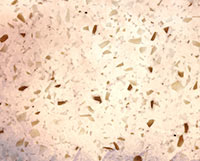 Poured terrazzo floors like those in that house are nowadays so astronomically expensive that the only new residential construction they are seen in today are high-end, architect-designed custom homes built for extremely wealthy people.
I wonder if people who replace poured terrazzo floors with hardwood, travertine, or whatever realize that they are discarding something very expensive for something much cheaper.
It even makes business sense. Even flippers could increase their profit margin if instead of replacing terrazzo, they just educated their buyers about how valuable these floors are. (Things that are revealed to be rare, expensive, and hard to replace have a way of magically becoming very attractive).” [august15, commenting on This Not-Screwed-Up-Yet Meyerland Ranch Mod, in Almost Original Condition, Is Available for $460K] Illustration: Lulu
Poured terrazzo floors like those in that house are nowadays so astronomically expensive that the only new residential construction they are seen in today are high-end, architect-designed custom homes built for extremely wealthy people.
I wonder if people who replace poured terrazzo floors with hardwood, travertine, or whatever realize that they are discarding something very expensive for something much cheaper.
It even makes business sense. Even flippers could increase their profit margin if instead of replacing terrazzo, they just educated their buyers about how valuable these floors are. (Things that are revealed to be rare, expensive, and hard to replace have a way of magically becoming very attractive).” [august15, commenting on This Not-Screwed-Up-Yet Meyerland Ranch Mod, in Almost Original Condition, Is Available for $460K] Illustration: Lulu
WHAT HAPPENS WHEN YOU STUCCOAT A BRICK SHOPPING CENTER IN COPPERFIELD 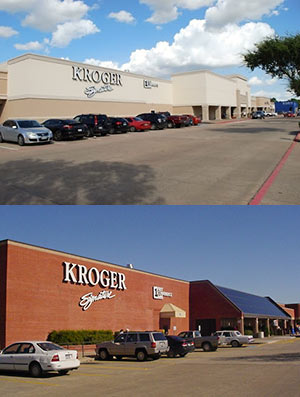 It’s not exactly a stucco jacket — a marketing brochure for the redone Easton Commons Shopping Center at the intersection of Hwy. 6 and West Rd. in Copperfield indicates the new coating and foam cornice (pictured at top) on top of the old brick structures (pictured at bottom) are actually Dryvit, a brand of EIFS, or a way to get that stucco look without all the layers and labor. (It’s Oyster Shell #456 above and Monastery Brown #381 below, plus Lantana Cobble Texas Stone on the columns, if you’re keeping score at home.) But Real Estate Bisnow’s Catie Dixon says the new brick-hiding exercise for the shopping center is “paying off” for its landlord: “in the five months since beginning renovations at Easton Commons, NewQuest’s Josh Friedlander and team have brought on eight new tenants totaling nearly 33k SF.” Among the newcomers drawn to all that relieving smoothness: Pet Club, UFC Gym, Beauty Empire, West Oaks Music Studio, and FJ Liquor. NewQuest Epic Investments will be building up a few freestanding buildings in the center facing Hwy. 6, Dixon reports, to make room for a new Smashburger, Verts Kebap, and a third unnamed restaurant, possibly (the brochure indicates) a Corner Bakery. [Real Estate Bisnow; brochure (PDF)] Photos: Catie Dixon (after); LoopNet (before)
It’s not exactly a stucco jacket — a marketing brochure for the redone Easton Commons Shopping Center at the intersection of Hwy. 6 and West Rd. in Copperfield indicates the new coating and foam cornice (pictured at top) on top of the old brick structures (pictured at bottom) are actually Dryvit, a brand of EIFS, or a way to get that stucco look without all the layers and labor. (It’s Oyster Shell #456 above and Monastery Brown #381 below, plus Lantana Cobble Texas Stone on the columns, if you’re keeping score at home.) But Real Estate Bisnow’s Catie Dixon says the new brick-hiding exercise for the shopping center is “paying off” for its landlord: “in the five months since beginning renovations at Easton Commons, NewQuest’s Josh Friedlander and team have brought on eight new tenants totaling nearly 33k SF.” Among the newcomers drawn to all that relieving smoothness: Pet Club, UFC Gym, Beauty Empire, West Oaks Music Studio, and FJ Liquor. NewQuest Epic Investments will be building up a few freestanding buildings in the center facing Hwy. 6, Dixon reports, to make room for a new Smashburger, Verts Kebap, and a third unnamed restaurant, possibly (the brochure indicates) a Corner Bakery. [Real Estate Bisnow; brochure (PDF)] Photos: Catie Dixon (after); LoopNet (before)
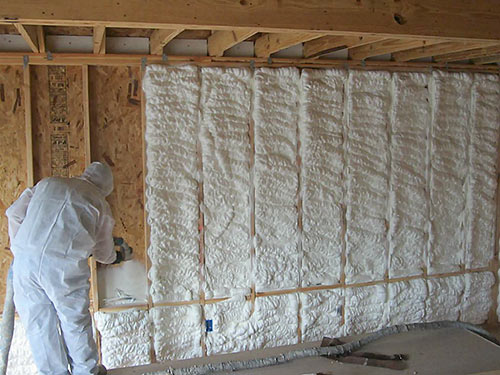
- 1916 Rosewood St. [HAR]
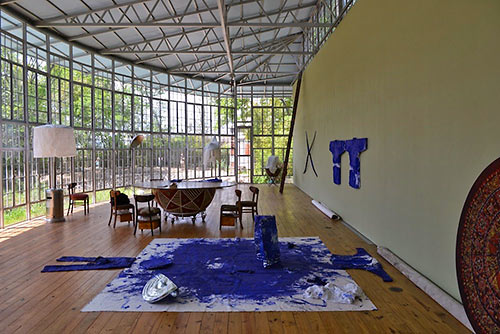
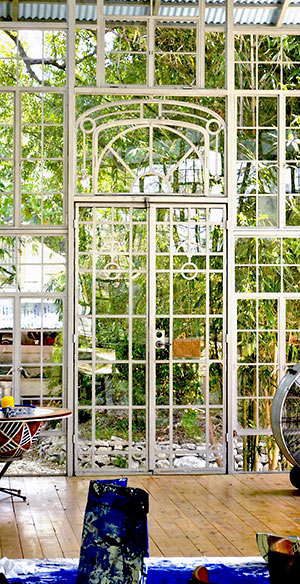 Local art guide Robert Boyd takes himself and readers on a photo tour of the outbuildings surrounding Nestor Topchy’s home “just south of the North Loop,” catching readers up on a few of the structures the artist has built since (or salvaged from) his residency at the legendary TemplO (earlier, Zocalo), the 6-acre arts commune he ran on a rented former truck depot at 5223 Feagan St. in the West End from the late eighties into the early aughts. And he finds much to impress, including the glass-walled tin-roofed structure pictured here, which Topchy pieced together from steel windows and doors salvaged from buildings in Houston and Argentina, and which fronts a pond on the acre-plus property. Topchy calls it the Crescent:
Local art guide Robert Boyd takes himself and readers on a photo tour of the outbuildings surrounding Nestor Topchy’s home “just south of the North Loop,” catching readers up on a few of the structures the artist has built since (or salvaged from) his residency at the legendary TemplO (earlier, Zocalo), the 6-acre arts commune he ran on a rented former truck depot at 5223 Feagan St. in the West End from the late eighties into the early aughts. And he finds much to impress, including the glass-walled tin-roofed structure pictured here, which Topchy pieced together from steel windows and doors salvaged from buildings in Houston and Argentina, and which fronts a pond on the acre-plus property. Topchy calls it the Crescent:
COMMENT OF THE DAY: GETTING RID OF WASTEFULNESS 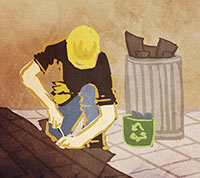 “It amazes me that we’ve become so rich as a society that we can collectively afford to have fashions of home improvements that will go in and out of style (although remain perfectly functional) the same way clothes do. The funniest to me is when you see on one of these HGTV shows someone espousing all the right ‘green’ mantras, but the first thing they do when they get the house it tear out all the perfectly functioning appliances, cabinets, counters and carpet…etc to be thrown in a dumpster. All the while feeling smug about how sustainable the place is because they are putting in bamboo flooring . . .” [longcat, commenting on Comment of the Day: Your ‘Updates’ Are Dating You] Illustration: Lulu
“It amazes me that we’ve become so rich as a society that we can collectively afford to have fashions of home improvements that will go in and out of style (although remain perfectly functional) the same way clothes do. The funniest to me is when you see on one of these HGTV shows someone espousing all the right ‘green’ mantras, but the first thing they do when they get the house it tear out all the perfectly functioning appliances, cabinets, counters and carpet…etc to be thrown in a dumpster. All the while feeling smug about how sustainable the place is because they are putting in bamboo flooring . . .” [longcat, commenting on Comment of the Day: Your ‘Updates’ Are Dating You] Illustration: Lulu
BUILDING TRIVIA IN THE WOODLANDS 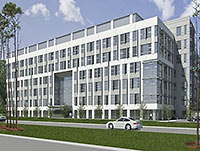 Real Estate Bisnow’s Catie Dixon reports a remarkable factoid about this 6-story, 154,213-sq.-ft office building that Stream Realty started construction on in August at 1585 Sawdust Rd. in the The Woodlands: When it’s done, writes Dixon, the so-called Reserve at Sierra Pines II, which is being built with 30-ft. panels swung into place by 300-ton cranes, will be the tallest tilt-wall building in Texas. [Real Estate Bisnow; previously on Swamplot] Rendering: Stream Realty Partners
Real Estate Bisnow’s Catie Dixon reports a remarkable factoid about this 6-story, 154,213-sq.-ft office building that Stream Realty started construction on in August at 1585 Sawdust Rd. in the The Woodlands: When it’s done, writes Dixon, the so-called Reserve at Sierra Pines II, which is being built with 30-ft. panels swung into place by 300-ton cranes, will be the tallest tilt-wall building in Texas. [Real Estate Bisnow; previously on Swamplot] Rendering: Stream Realty Partners
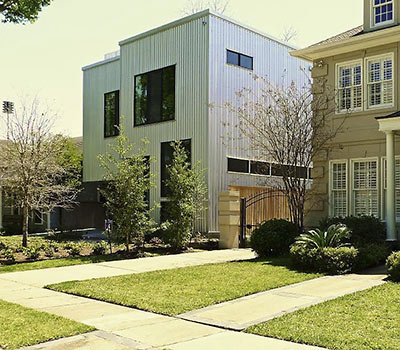
That steel frame on Centenary St. that roused some West U residents to name-calling and concern-raising 2 years ago now has a steel house built around it — and a single father and his two sons inside. Still, says architect Cameron Armstrong, the build wasn’t as smooth as it might have been: “[C]ertain neighbors were actually quite hostile — they heckled the subcontractors (and not always from across the street!), and made numerous frivolous complaints to the police about things like (non-existent) parking violations by workers. . . . They thought they were living on a street with a predictable visual future, which turned out not to be the case.” Adds Armstrong: “[I]t’s hard to identify substantive objections. . . . The good news is that most of the neighbors are just fine with how the design turned out.”
That there’s some pretty bad Feng Shui going down in this commercial for Honda, which was filmed in Vancouver and shown on teevee and the web beginning last October. The man behind the wheel of the CR-V sure is driving some bad chi into the gullet of the far-from-the-prairie home at the end of the T-intersection, to the encouraging narration of Garrison Keillor. But isn’t the house kinda asking for it anyway, what with all that glimmering vortex-popping and all?
And gee, doesn’t the hole stabbing through the house look a heck of a lot like . . . that temporary sculpture that stood on Montrose Blvd. in Houston a few years back? Portal to another dimension? Naah — from here it looks more like a shortcut to Grant St.

